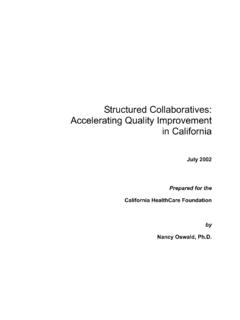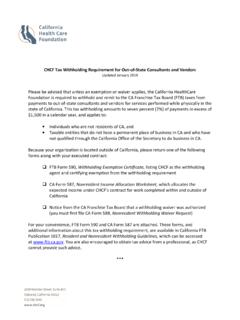Transcription of Buprenorphine: Everything You Need to Know
1 1 Buprenorphine: Everything You Need to KnowBuprenorphine, a medication that is FDA-approved for addiction treatment and pain relief, has also been found to dramatically decrease death rates from opioid overdose. Only 10% of patients needing treatment, however, have access to the medication. This document provides answers to frequently asked questions about buprenorphine and supplements the California Health Care Foundation (CHCF) webinars Expanding Access to Buprenorphine in Primary Care Practices and Is Buprenorphine for Pain a Safer Alternative to High-Dose or Long-Term Opioid Use?
2 1, 2 The clinical information contained in this paper is intended to act as a guideline, not a replacement for onsite medical judgment. Based on information cov-ered in the CHCF webinars, the content was reviewed by addiction specialists Howard Kornfeld, MD, James Gasper, PharmD, and Andrew Herring, MD. BackgroundBuprenorphine is an opioid medication approved by the Food and drug Administration (FDA) for treatment of opioid dependence and for acute and chronic pain. It is a partial opioid agonist, meaning that it acts on certain opioid receptors in the brain, providing potent relief from pain and from opioid withdrawal symptoms, while acting as an antagonist on other opioid receptors, resulting in its unique has a ceiling effect on respiration; that is, increasingly higher doses do not affect breath-ing in the same way that other opioids do.
3 Deaths due to buprenorphine overdoses are rare and usually involve multiple medications ( , benzodiazepines, alcohol, other opioids or intravenous use). Some formulations (higher dose sublingual tablet, sublingual film, and implant) are FDA-approved for opioid use disorder, while Buprenorphine: Everything You Need to Know OCTOBER 2016others are FDA-approved for pain (injectable, patch, and buccal mucoadhesive film). Per the drug Addiction Treatment Act of 2000 (DATA 2000), physicians need a waiver to prescribe buprenor-phine for addiction; attendance in an eight-hour in-person or online course is required to obtain a waiver.
4 The Comprehensive Addiction and Recovery Act of 2016 allows nurse practitioners and physician assistants to pre-scribe buprenorphine treatment after 24 hours of certified training. Clinicians are capped at 30 patients the first year and 100 patients per year thereafter. The cap increases to 275 patients for physicians board-certified in addic-tion, or those in practices that meet certain qualifications: 24-hour call coverage, use of health information technol-ogy, provision of care management services, registration with cures (Controlled Substance Utilization Review and Evaluation System, California s prescription drug monitor-ing database), and acceptance of third-party insurance.
5 Patients using buprenorphine for pain relief and not addiction are not included in federal cap provider licensed by the drug Enforcement Administration (DEA) ( , physician, nurse practitio-ner, physician assistant) can prescribe buprenorphine for pain. As a Schedule III drug , buprenorphine can be ordered by phone or fax, and refills can be included on the original prescription . In contrast, Schedule II drugs, such as hydrocodone, require tamperproof prescriptions and one-month supply limits with no with buprenorphine has been proven effective in opioid addiction, decreasing mortality by approxi-mately 50%.
6 Patients treated with buprenorphine show improved social functioning with increased retention in treatment (67% at one year) compared to drug -free treat-ment (7% to 25% at one year), reduced criminal activity, lower rates of illicit substance abuse, and reduced risk of HIV and hepatitis - 82 California Health Care Foundation California does not have adequate buprenorphine prescribers to meet the growing demand for treatment. Buprenorphine is a potent pain reliever with particular advantages for patients with chronic pain or pain com-plicated by opioid dependence. Although traditional practice has been to discontinue buprenorphine during hospital admissions, new research shows that buprenor-phine can be continued when patients are admitted to the hospital, with pain controlled by other opioids used on top of the baseline buprenorphine -11 Studies of patients on high-dose opioids transitioned to sublin-gual or buccal buprenorphine have shown improved pain control, improved control of psychiatric symptoms, and much lower risk of overdose.
7 13 Patients commonly start buprenorphine in a clinician s office after 12 to 48 hours of withdrawal symptoms a process known as an induction since sublingual buprenorphine often causes severe withdrawal symp-toms if started shortly after use of other opioids. Patients with pain diagnoses can avoid these symptoms, however, by using a fentanyl or buprenorphine patch, which mini-mizes or eliminates withdrawal It should be noted that these patches are FDA-approved for pain, not addiction: A DEA letter clarified that there is no restric-tion on the use of buprenorphine for pain relief (even for the high-dose sublingual formulations approved for addiction and prescribed off-label for pain).
8 15 To increase convenience for the patient and decrease the burden on the office practice, home inductions are now in more frequent use; in these cases, the patient is given instruc-tions on when to take the first dose and how to monitor withdrawal does not have adequate buprenorphine pre-scribers to meet the growing demand for treatment. As a result, only 10% of those needing opioid addic-tion treatment with buprenorphine are able to access it. Buprenorphine remains inaccessible to most patients with addiction or chronic pain due to many obstacles: not enough waivered physicians, lack of understanding about its use, the paperwork burden from health plan authorization requirements and from tracking patients to stay under the cap limit.
9 To overcome these obstacles, in 2015 Medi-Cal removed authorization requirements from buprenorphine sublingual and patch Studies on BuprenorphineThe following are important studies on buprenor-phine s effectiveness in treating opioid addiction:$$A randomized, controlled study from Sweden compared detox plus placebo to detox plus maintenance buprenorphine: 4 out of 20 (20%) died of overdose in the first year in the placebo group, compared to 0 deaths in the buprenorphine $$Patients on opioid maintenance therapy (buprenorphine or methadone) are less likely to contract hepatitis C and ,18$$More than 9 of 10 people continue to use opioids after an overdose event.
10 An overdose should be a signal that the patient is at high risk of death, immediately triggering a plan to taper to a safer regimen of prescribed opioids, offer take-home naloxone, or consider addic-tion treatment (buprenorphine or methadone) when $$The prescription Opioid Addiction Treatment Study (POATS) trial evaluated short- and long-term buprenorphine treatment. Of those patients tapered off at 12 weeks, 9% reported abstinence compared to 50% of those continu-ing treatment. Patients using buprenorphine were more than twice as likely to report abstinence at 18 months compared to those who were not using buprenorphine (80% versus 37%); the difference persisted at 42 months (80% versus 51%).









